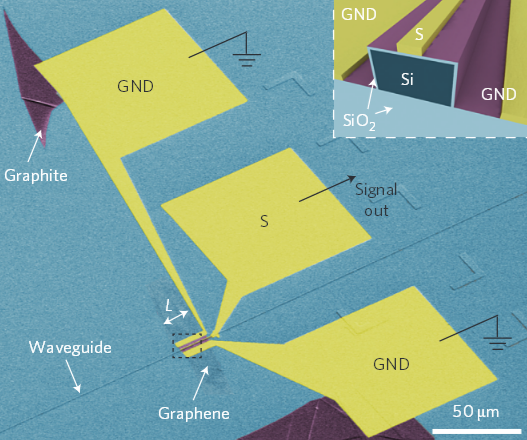Integrating a graphene photodetector into a computer chip
Graphene can convert all telecommunications wavelengths, unlike germaniuim
September 25, 2013
[+]
Vienna University of Technology scientists have succeeded in combining
graphene photodetectors with semiconductor chips, allowing for
transforming light used in telecommunications (such in as fiber optics)
into electronic signals.
Waveguide-integrated
graphene photodetector. The active region of the graphene sheet is
shown in violet. The inset shows a cross-section of the device. The
graphene sheet coats both the top surface and sidewalls of the
waveguide. A thin silicon dioxide layer prevents electrical contact
between graphene and the silicon waveguide. (Credit: Andreas Pospischil
et al., Nature Photonics)
Two years ago, the team of Thomas Müller (Institute of Photonics, Vienna University of Technology) demonstrated that graphene is ideally suited to turn light into electrical current, allowing for fast conversion,” says Müller.
“A narrow waveguide with a diameter of about 200 by 500 nanometers carries the optical signal to the graphene layer. There, the light is converted into an electronic signal, which can then be processed in the chip,”,Müller explains.
Broadband performance
There have been attempts to integrate photodetectors made of other materials (such as Germanium) directly into a chip.
But these materials can only process light in a specific wavelength range. The researchers showed that graphene can convert all wavelengths used in telecommunications equally well.
The graphene photodetector is also compact: 20 000 detectors can fit onto a single chip with a surface area of one square centimetre. Theoretically, the chip could be supplied with data via 20 000 different information channels.
Optical data transmission also becomes more and more important within computers themselves,” says Müller. “When large computer clusters work with many processor cores at the same time, a lot of information has to be transferred between the cores. Graphene allows switching between optical and electrical signals very quickly. This speeds up data exchange and requires much less electrical energy.
“The mechanical flexibility of graphene also enables integration with bendable substrates,” Müller explained to KurzweilAI. “We envision that graphene could play a role in realizing various active components in polymer-based optical circuits with 10 or more years.
“The main drawback of our graphene photodetetctor is its 5–10 times smaller sensitivity, compared to germanium, but we have some ideas how to improve it.”
(¯`*• Global Source and/or more resources at http://goo.gl/zvSV7 │ www.Future-Observatory.blogspot.com and on LinkeIn Group's "Becoming Aware of the Futures" at http://goo.gl/8qKBbK │ @SciCzar │ Point of Contact: www.linkedin.com/in/AndresAgostini
 Washington
Washington